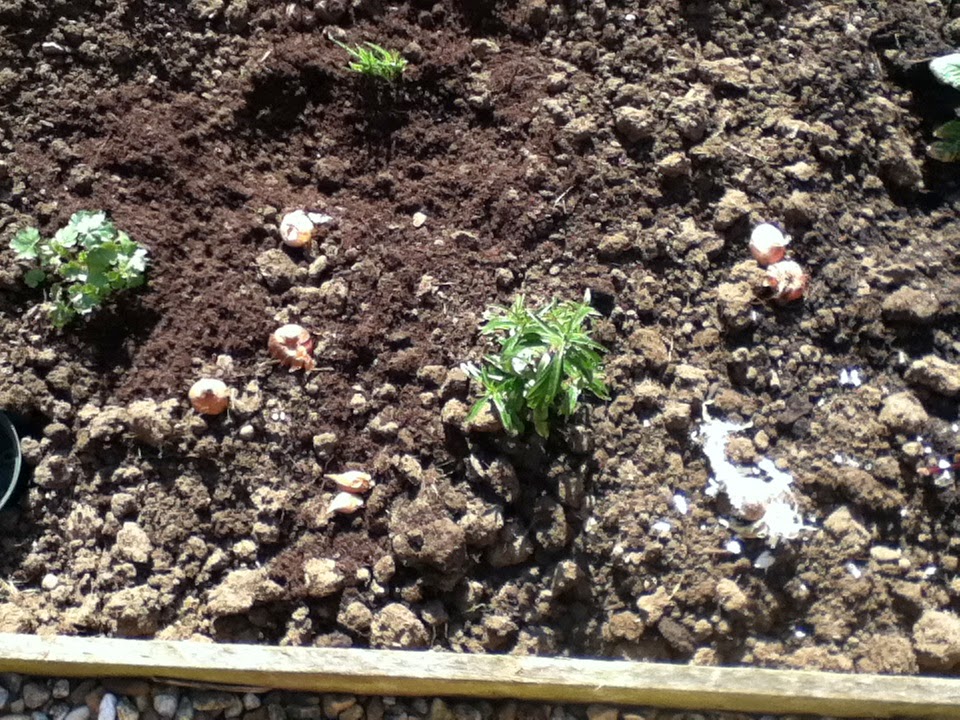Nothing quite like it ........................ well that's true enough and happy are we that at last we've arrived somewhere with very friable soil. This is quite the Rolls Royce of mud and such a luxury, I'm half tempted to boast about it in the Co-Op
"Oh, hello I'm your new neighbour. Bet you'd like to be me right, forget the patio and room for a BBQ, we've got mud that just crumbles up in your fingers. Eh? Eh? You have a nice day now, y'hear"
May not endear me locally but you can only imagine my pride as previously we've only known claggy earth thick with clay and absolutely chock-a-block with stones and flints. Quite literally more stone than earth, making it a near impossibility to dig deep enough to plant anything.
"Oh, hello I'm your new neighbour. Bet you'd like to be me right, forget the patio and room for a BBQ, we've got mud that just crumbles up in your fingers. Eh? Eh? You have a nice day now, y'hear"
May not endear me locally but you can only imagine my pride as previously we've only known claggy earth thick with clay and absolutely chock-a-block with stones and flints. Quite literally more stone than earth, making it a near impossibility to dig deep enough to plant anything.
At last the new bed is fully complete so we can now
get on with planning how we’d like our scheme to look and begin planting
out.
So, we have our lovely crumbly soil, but is it nutrient rich, this we don't know so we took the earlier precaution of enriching it with added matter and manure. So maybe first thing, best rush out and buy a soil testing kit. Right??
Wrong
SNERK
The pros will advise you that in unfamiliar territory this is the best
thing to do to ensure that you use plants correctly suited to your soil
type.
Not happening.
You can check these kits out on line.
They can rush you around £80 a pop and that’s by no means the most
expensive, some come in at £130.
£ker-ching
OUCH – they’ll not be seeing
any 80 of my quids. Think of all the new plant friends we could
get for that and refer to Mulching (last
post).
They’re having us on.
It’ll all
work out with a bit of trial & error. Some plants will happily thrive and
some will just turn up their toes and check out – no explanation needed. They might tell you:
“it’s not you, it's me”
but however the mop flops you won’t get 100% success, the slugs and their snail mates will see to that.
“it’s not you, it's me”
but however the mop flops you won’t get 100% success, the slugs and their snail mates will see to that.
So keep your hand
on your ha’penny and see next month's post (Cheap as Chips http://imdiggingthis.blogspot.co.uk/2015/05/cheap-as-chips.html ) for plant bargains galore.
Of course some plants do need specialist conditions. We know that.
The most common one you’ll butt up against is the Rhodies, Azaleas
and Camellias which require an ericaceous (or acid to simplify) soil, but you can get
round that in a variety of ways. By conditioning the soil around each plant,
introducing a liquid feed at intervals or planting smaller varieties in a tub, enriched with
the correct compost, where they’ll happily do sterling service for you for many
years.
We're using the separate beds we've created here at our USG-Plot as two distinct areas. One for the perennials which we’ve chosen not
to mix with the annuals, for this first year at least. As a rule of thumb quite a lot of the more
hardy plants, oriental poppies, herbaceous cornflowers, dicentra, iris and
peonies together with many shrubs: for instance lilac, kerria, magnolia,
forsythia and clematis are early flowering and tend to be finished by the beginning of
June, so really just when you're outside enjoying the best of the summer most of the impressive showier blooms will be over. The idea here then is to have one bed
flowering which will then we superseded by a second drift of colour as the
annuals begin showing of their best.
Or to cut to the chase the Mexican Wave of gardening.
Or to cut to the chase the Mexican Wave of gardening.
Working hard to avoid our most often repeated past mistake of overcrowding and smooching the plants up too close together to try and fit in the maximum amount, without giving them space to develop. This always results in the stronger species completely dominating any more tender varieties which don't survive.
1 For continued follow-on flowering and
2 For optimum spacing at this stage to make best use of available area
The established plants we're using here are a mixture of some root cuttings taken from our previous garden and brought with us, some of which survived the winter, some not. Together with a very few new additions bought this year.
These consist of mainly failsafe varieties to give our new 2015 zero to hero garden the best possible chance of success. No prima donnas of the plant world, big on attitude, short on results.
Can't grow won't grow, then out you go.
Time to get busy potting on .......................... See you there







No comments:
Post a Comment